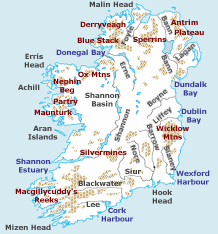River Bann

The River Bann (Template:Lang-ga) is the longest river in Northern Ireland, the total length being 80 miles (129 km). The river winds its way from the south east corner of the province to the north west coast, pausing in the middle to widen into the enormous Lough Neagh. The river has played an important part in the industrialisation of the north of Ireland, especially in the Linen Industry. Today Salmon and Eel fisheries are the most important economic features of the river. The river is often used as a dividing line between the eastern and western areas of Northern Ireland, often labelled the "Bann divide". Towns, councils and businesses "west of the Bann" are often seen as having less investment and government spending than those to the east.[1] In the past it was also seen as a religious or political divide, with Catholics or nationalists being in the majority to the west, and Protestants or Unionists in the majority to the east.[2][3]
Upper Bann
The Upper Bann rises in the Mourne Mountains in County Down and flows into Lough Neagh at Bannfoot, County Armagh. This stretch is one of the most popular coarse fishing rivers in Europe. Near Portadown it connects with the now disused Newry Canal, which once gave access south to the Irish Sea.
Lower Bann
The Lower Bann flows from Lough Neagh at Toome to the Atlantic Ocean at Portstewart. The river is a canalised waterway with five locks along its 38 miles (51km). The river is very popular with water sports enthusiasts, anglers and cruisers and has minimal commercial traffic. It acts as most of the border between County Antrim and County Londonderry. The only commercial port on the river is at Coleraine. Ships from Londonderry Port and the Port of Belfast transfer coal and scrap metal.
See also
References
External links
- Discover Northern Ireland - Upper Bann
- Discover Northern Ireland - Lower Bann
- Waterways Ireland - Lower Bann information page.
